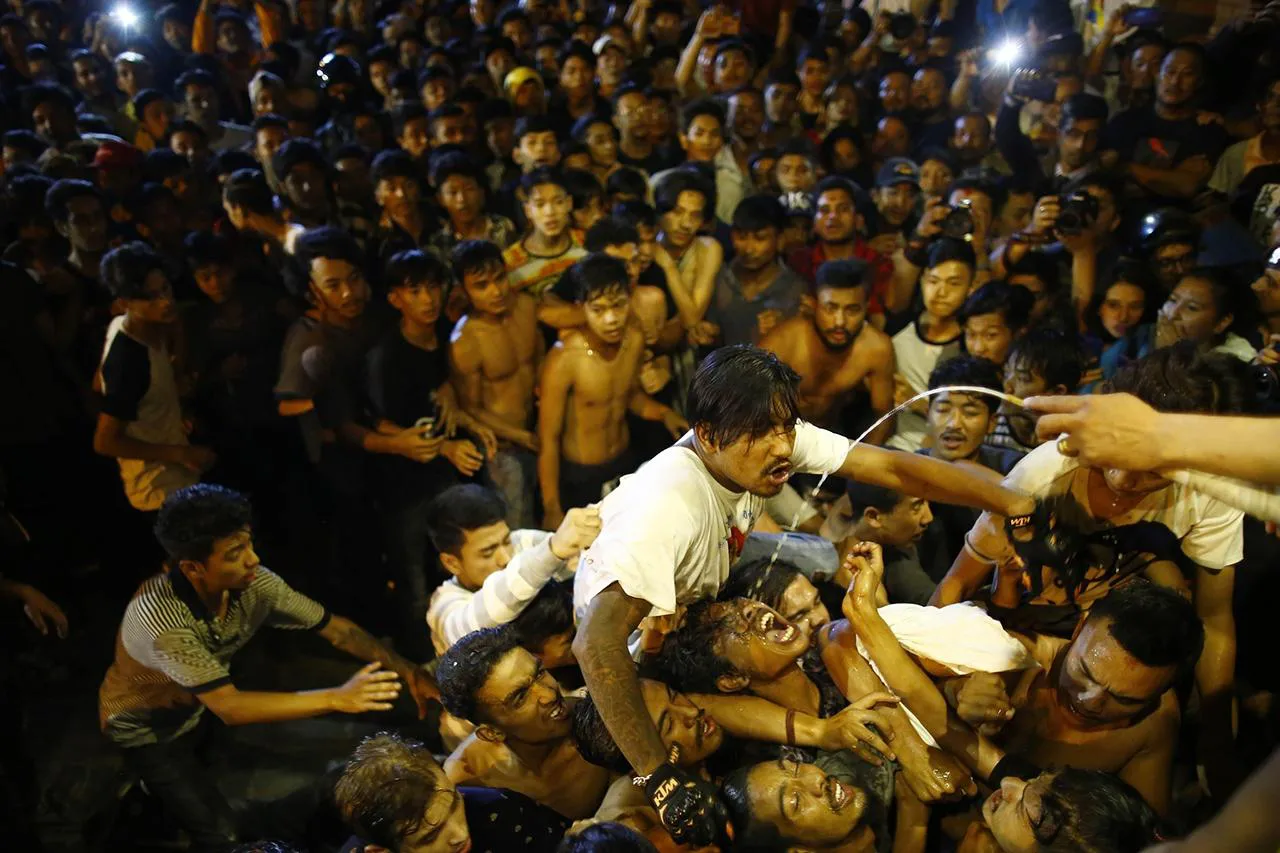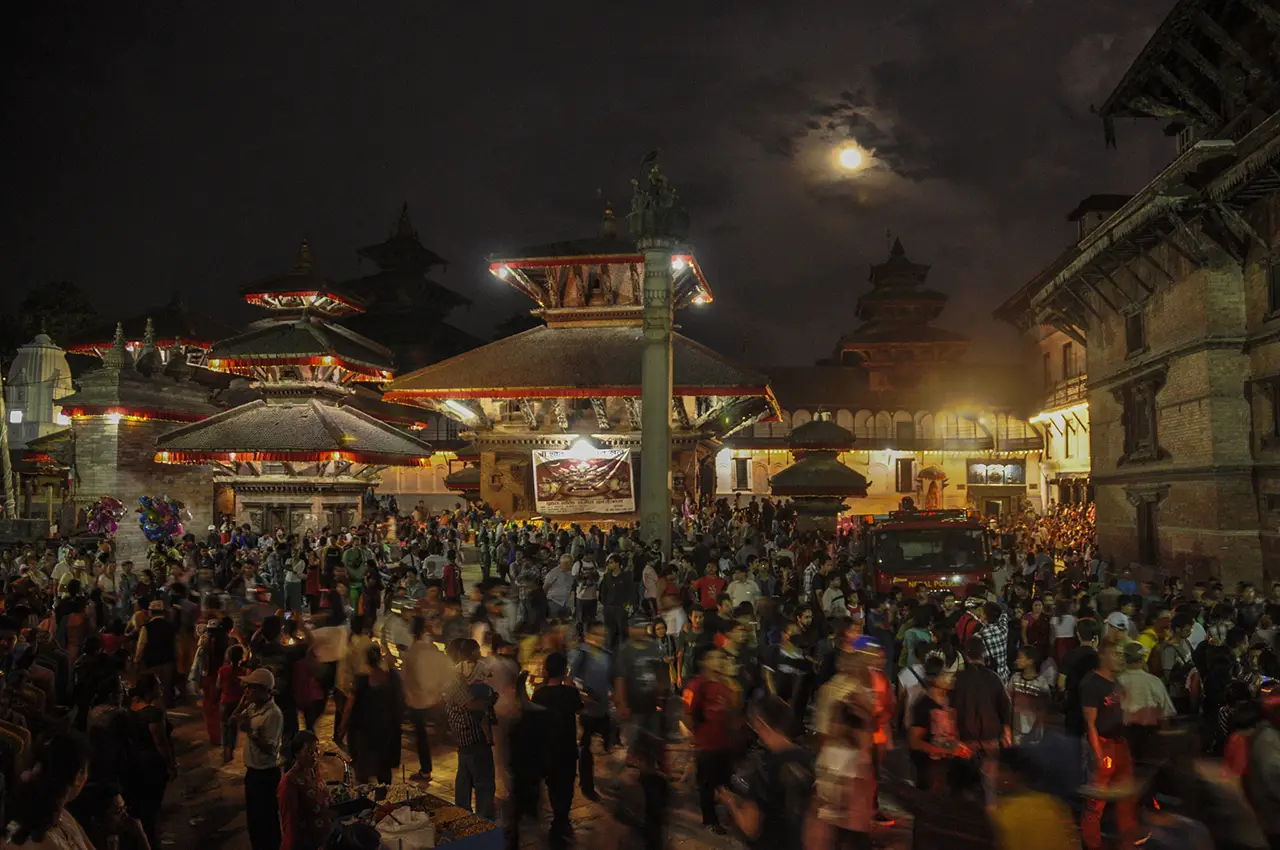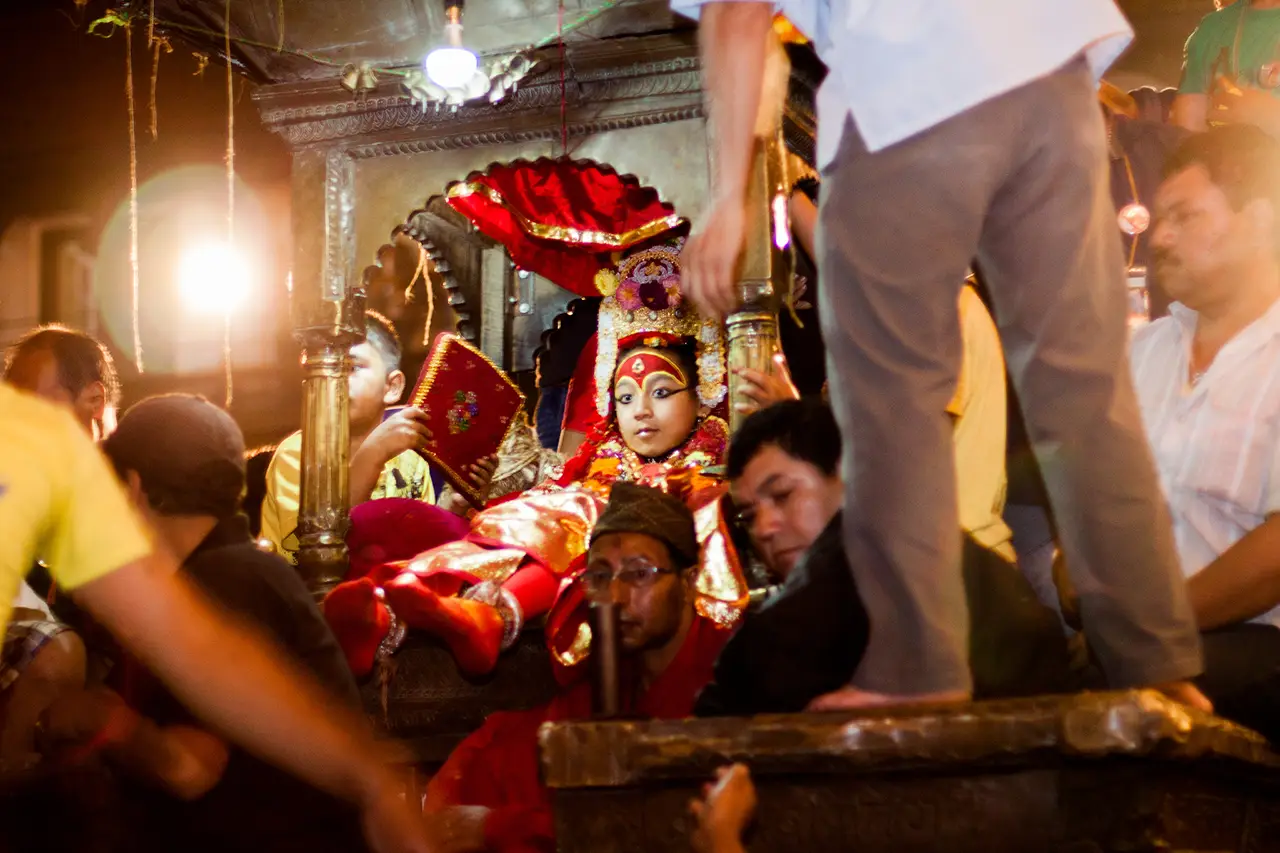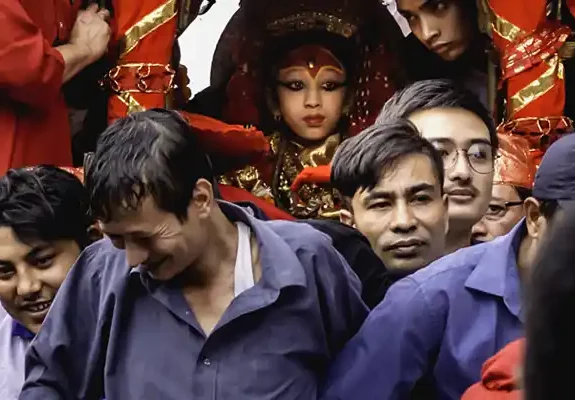Indra Jatra, also known as Yenya, is a vibrant and profoundly spiritual festival celebrated in the heart of Kathmandu Valley, Nepal. This ancient festival dates back to the 10th century and is held annually to honor Lord Indra, the Hindu god of rain and the king of heaven. The rains have ended, and Indra Jatra is a grand celebration for eight days that includes culture and religion; it is an exciting event for the city folk and the tourists.
In fact, outside Kathmandu, this festival is one of Nepal’s oldest and most esteemed celebrations. Parades fill the streets with people dancing in masks, and folk tunes echo everywhere. The Newar people value this festival and actively involve their traditions and practices in the processions.

Highlights of Indra Jatra Festival in Kathmandu Valley
- Kumari Jatra: Kumari Jatra forms an essential segment of Indra Jatra when the living goddess Kumari is paraded around Katmandu city’s roads using a chariot. Many devotees come to her to receive her blessing.
- Masked Dances: The festival features traditional masked dances like the Lakhey and Pulukishi. Performers reenact mythical stories through these dances, which they believe drive away evil spirits.
- Raising the Yosin (Indra’s Pole): One of the most important rituals of Indra Jatra is the raising of the Yosin, a ceremonial pole representing Lord Indra. This event marks the beginning of the festival and symbolizes divine protection.
- Exhibition of Sacred Artifacts: During the festival, several temples in Kathmandu are opened to the public, allowing devotees to view sacred artifacts only displayed during Indra Jatra.
- Procession of Indra’s Effigy: Devotees carry an effigy of Lord Indra through the streets as part of a grand procession. According to the ancient legend, this tradition symbolizes Indra’s imprisonment by the people of Kathmandu during the festival.
- Devotional Offerings: Devotees offer flowers, fruits, and other items at shrines dedicated to Lord Indra and other deities. The air is filled with the fragrance of incense, adding to the spiritual atmosphere.
- Community Involvement: Indra Jatra Nepal is a time for communities to unite and participate in various cultural and religious activities. The festival fosters a strong sense of unity and cultural pride among the residents of Kathmandu Valley.
- Traditional Music: The streets resonate with the sound of traditional musical instruments like the dhimay drums and the bansuri flute. The music enhances the festive ambiance and reflects Nepal’s rich cultural heritage.
Historical and Mythological Origins of Indra Jatra
Indra Jatra, or Yenya, holds deep roots in the history and mythology of the Kathmandu Valley. This festival honors Lord Indra, the king of heaven and the god of rain. In Hindu mythology, Indra plays a vital role as the bringer of rain, which is essential for agriculture in Nepal. Because of this, communities across the valley celebrate Indra for ensuring prosperity through adequate rainfall for crops.
Mythological Background
An ancient legend explains the origin of this festival. Lord Indra once descended to earth searching for Parijat, a rare flower for his mother, Goddess Dakini. Disguised as an ordinary man, Indra tried to gather the flowers in the Kathmandu Valley. However, the local people, unaware of his divine nature, captured and tied him up. His mother eventually revealed his true identity, and the locals released him. In gratitude, Indra promised to bless the valley with ample rain for their crops.
This legend ties the festival to the region’s agricultural cycle. The event occurs at the end of the monsoon season when farmers prepare for the harvest. People in Kathmandu express their hope for continued rain blessings by honoring Indra.
Historical Importance
King Gunakamadeva initiated the celebration in the 10th century to mark the founding of Kathmandu. Since then, it has evolved into one of the most important cultural events in the valley, blending religious traditions with community unity. Over time, this event became one of the most important celebrations in the valley. It symbolizes a unique blend of Hindu and Buddhist traditions while fostering a strong sense of community.
During the festivities, the streets of Kathmandu come alive with traditional music, dances, and rituals passed down through generations. These celebrations pay tribute to Indra and offer a time of thanksgiving for a successful monsoon season and hope for future agricultural prosperity.

Exploring the Vibrant Rituals and Events of Indra Jatra
The annual festival of Indra Jatra is associated with vibrant celebrations in Kathmandu, Nepal. It is a tapestry of rich cultures characterized by rituals that link the divine to the community. Every event during this festival has a profound significance and reflects the region’s religious and cultural heritage.
Kumari Jatra: A Procession Honoring the Living Goddess
- The Living Goddess: Kumari Jatra honors the Kumari, a young girl revered as a living goddess who represents the goddess Taleju.
- Chariot Procession: Devotees pull an intricately designed chariot carrying the Kumari through the streets of Kathmandu. Thousands gather to witness this remarkable event during the Indra Jatra festival.
- Spiritual Significance: Many believe that seeing the Kumari during the procession brings blessings and good fortune, especially for health and prosperity.
Lakhey Dance: A Dynamic Performance of Demonic Spirits
- Masked Performers: The Lakhey Dance features performers in large, grotesque masks and vibrant costumes representing demons.
- Cultural Expression: The performers engage the audience with energetic, dramatic movements, which many believe help ward off evil spirits.
- Community Involvement: The dancers interact with the crowd, drawing spectators into the lively performance and making them part of the celebration.
Pole Raising (Lingo): Celebrating Divine Arrival
- Raising the Lingo: The community raises a tall wooden pole called the terminology to mark the beginning of the Indra Jatra festival. This act symbolizes Lord Indra’s descent from heaven to the earthly realm.
- Community Effort: Erecting the lingo requires a coordinated effort, showcasing the unity and collective strength of the community.
- Symbolic Importance: The lingo stands tall throughout the festival, reminding everyone of Indra’s presence and divine protection over the city.
Indra’s Capture and Release: A Reenactment of Mythology
- Dramatic Storytelling: Performers reenact the story of Lord Indra’s capture during the festival. The myth describes how the people of Kathmandu unknowingly captured Indra when he descended to earth disguised as an ordinary man to gather flowers.
- Symbolic Representation: This reenactment illustrates the connection between humans and the divine and the importance of respecting the gods.
- Moral Lessons: The tale reminds festival-goers of the virtues of humility and the importance of maintaining a respectful relationship with the natural and divine worlds.
Cultural Significance of Indra Jatra
Indra Jatra is one of the most revered festivals in Kathmandu, Nepal. This event is of profound cultural and religious importance to the Newar community. Celebrated at the close of the monsoon season, Indra Jatra strengthens the rich cultural and spiritual traditions of the Newars. Here’s how this festival supports the cultural heritage of the Kathmandu Valley:
Reinforcement of Cultural Identity
- Highlighting Newar Traditions: Indra Jatra brings Newar traditions to life through vibrant displays of music, dance, and rituals that emphasize the unique aspects of their culture.
- Preserving Ancient Customs: From the Kumari chariot procession to the energetic Lakhey Dance, every festival ritual upholds centuries-old customs, ensuring that these traditions endure for future generations.
Strengthening of Community Bonds
- Active Participation: The Newar community actively engages in festival preparations and rituals, which fosters a strong sense of unity and belonging among its members.
- Cultural Exchange Between Generations: During the festival, older generations share cultural knowledge and spiritual practices with the younger ones, passing down their heritage.
Spiritual and Religious Significance
- Devotion to Deities: Indra Jatra features a wide range of devotional activities, honoring multiple gods and goddesses central to Newar spirituality.
- Renewing Faith: The Newar community reaffirms their spiritual beliefs through the rituals performed during the celebration, renewing their faith each year.
Impact on Kathmandu’s Cultural Landscape
- Drawing Visitors: The festival attracts tourists to Kathmandu, boosting local tourism and giving international visitors a chance to learn about Newar culture.
- Cultural Pride: The widespread celebrations throughout Kathmandu showcase the Newar community’s pride in their cultural and religious heritage.

Social and Economic Impact of Indra Jatra
Indra Jatra is significant in the valley of Kathmandu concerning social issues and economics. An annual event brings people together and dramatically boosts the locality’s economic growth. In this essay, we discuss how this colorful festival encourages interaction within a community and promotes a spirit of economic development through tourism and festivities:
Strengthening Community Bonds
- Building Social Connections: Families, neighbors, and friends actively participate in preparing for the festival, which strengthens social connections within the community. These collaborative efforts create a stronger sense of unity among the Newar people.
- Encouraging Cultural Exchange: The festival attracts people from different regions of Nepal and international visitors, creating an opportunity for cultural exchange. This interaction allows for a greater appreciation and understanding of Newar traditions, extending beyond the local community.
- Celebrating Inclusivity: The festival welcomes people from all backgrounds, regardless of age, gender, or status. This inclusiveness encourages everyone to participate in cultural and religious activities, which fosters social cohesion.
Supporting the Local Economy
- Attracting Tourists: The festival draws thousands of tourists to Kathmandu, significantly boosting the local tourism industry. Increased business benefits hotels, restaurants, and travel agencies, positively impacting the local economy.
- Creating Economic Opportunities: The festivities develop economic opportunities for local vendors, artisans, and performers. Street stalls offering food, handicrafts, and traditional items flourished during this period, providing an essential source of income for many families.
- Preserving Culture Through Commerce: The economic benefits generated by the festival help preserve Newar culture. As local businesses thrive, they continue to produce traditional goods and services that reflect their heritage, ensuring that these practices endure.
Enhancing Kathmandu’s Economic Landscape
- Generating Festival Revenue: The festival brings increased spending to various sectors, including retail, transportation, and hospitality, positively impacting Kathmandu’s overall economic landscape.
- Sustaining Local Businesses: The festival’s financial boost helps local businesses remain viable throughout the year. This support enables them to continue producing traditional crafts and services, preserving the region’s cultural identity.
Modern Celebrations and Changes in Indra Jatra
Indra Jatra, one of Kathmandu’s major festivals in Nepal, is still very dynamic. It is dynamic as before but evolves through changing times without losing sight of its cultural significance. The festival, deeply anchored in tradition, now fits into the modern environment by addressing its advantages and disadvantages like any other old thing. We shall examine how this celebration manages to strike a balance between the new and the old.
Evolving Traditions
- Using Technology: Technology now allows people to experience the festival in new ways. Live broadcasts on social media and online platforms let those who cannot attend in person enjoy the festivities. This digital outreach keeps younger generations and the global community connected to the celebrations.
- Improving Accessibility: Infrastructure developments in Kathmandu have made the festival more accessible to a larger audience. Enhanced transportation and better facilities allow more people to participate in or visit the event, increasing its reach and popularity.
Challenges of Modernization
- Maintaining Authenticity: As the festival gains global popularity, the community faces the challenge of preserving the authenticity of traditional rituals. Increased tourism and commercialization can dilute cultural significance if not managed carefully.
- Avoiding Cultural Dilution: Globalization risks reducing the uniqueness of traditional practices. Preserving the festival’s core traditions remains essential to maintaining its cultural identity.
Balancing Tradition and Modernity
- Community Leadership: The Newar community actively works to balance modern influences with traditional practices. Leaders and cultural organizations educate younger members and newcomers about the importance of each ritual, ensuring that tradition continues.
- Eco-Friendly Celebrations: Some festival elements have adapted to modern concerns, such as using eco-friendly materials for decorations and offerings. These changes promote sustainability while honoring age-old customs.
Globalization’s Impact
- Gaining International Attention: As the festival attracts more international visitors, it benefits the local economy and creates challenges in managing larger crowds and protecting sacred spaces.
- Encouraging Cultural Exchange: The festival serves as a platform for cultural exchange, welcoming people worldwide to learn about Newar traditions. While this enriches the event, it also requires careful handling to prevent cultural appropriation.

Community and Personal Stories of Indra Jatra
In Kathmandu, Nepal, Indra Jatra represents more than a cultural and religious event. It creates a deeply personal and communal experience for everyone involved. Through personal stories and insights, this article explores the emotional and spiritual impact that Indra Jatra has on participants.
Personal Reflections on Indra Jatra
- A Participant’s Perspective: Sunita, a resident of Kathmandu, participates annually in the Kumari Jatra procession. She shares, “Every time I see the Kumari, our living goddess, I feel a deep sense of peace and connection to my roots. Her presence reminds us of our rich heritage and offers us spiritual protection.”
- A Family Tradition: Rajan, whose family has organized the Lakhey Dance for generations, expresses his pride, saying, “Taking part in the Lakhey Dance is not just a responsibility; it honors my ancestors and ensures that our traditions endure for future generations.”
Emotional and Spiritual Experiences
- Renewing Spirituality: Many participants view Indra Jatra as a time for spiritual renewal. Bishnu, an elder in the Newar community, explains, “This festival allows us to cleanse our spirits and seek blessings for health and prosperity. The rituals, especially the pole raising, strengthen our connection to the divine.”
- Building Community Unity: The festival unites people across all sectors of Newar society. Aarav, a young attendee, reflects, “Indra Jatra breaks down barriers and brings us together. It’s more than a celebration; it’s a time when we stand as one community.”
Highlighting Human Stories
- A Craftsman’s Insight: A local artisan who creates traditional masks for the festival shares his experience, “Every mask I craft carries a piece of our history. This work sustains my livelihood and preserves our cultural stories and identity through these creations.”
- Visitor Impressions: Maria, a tourist from Italy, shares her thoughts, “The vibrant energy, the colors, and the sense of unity during the festival amazed me. It’s an unforgettable experience that truly moved me.”
Challenges and Controversies Surrounding Indra Jatra
Indra Jatra, celebrated passionately in Kathmandu, Nepal, faces contemporary challenges as it seeks to uphold its rich traditions. While deeply rooted in the cultural and spiritual life of the Newar community, the festival must address issues like animal welfare and urban development. Below, we explore how these modern concerns are impacting this long-standing celebration.
Concerns Over Animal Welfare
- Balancing Tradition and Animal Rights: Certain rituals within the festival involve the use of animals, sparking debates among animal rights activists. These practices have raised ethical concerns, leading to discussions on maintaining traditions while ensuring the humane treatment of animals.
- Adapting to Modern Values: In response to these concerns, some organizers and community leaders are considering alternatives to rituals that involve animals. Their goal is to honor cultural heritage while aligning with modern ethical standards.
Managing Crowds Safely
- Dealing with Overcrowding: As the festival attracts more participants each year, managing the growing crowds of locals and tourists has become increasingly complex. Overcrowding brings safety risks, including the potential for accidents and stampedes.
- Enhancing Security Measures: To address these risks, authorities and festival organizers have stepped up their efforts to improve crowd management. They are focusing on better event space planning, implementing stricter security protocols, and preparing clear emergency response plans to ensure the safety of everyone attending.
The Impact of Urban Development
- Challenges of Urbanization: Rapid urban development in Kathmandu has impacted the spaces traditionally used for festival events. Shrinking or restricted venues can affect the ceremonies and processions central to the celebration.
- Preserving Cultural Spaces: Efforts are underway to protect historical and cultural sites vital to the festival’s character. Cultural preservationists and urban planners work together to ensure that modern development does not erase the festival’s deep historical roots.
Navigating These Modern Challenges
- Finding a Balance: The festival must keep its traditions and change to fit today’s world.
- Collaborating with the Community: Dialogue with community members and policymakers helps create solutions that respect the festival’s traditions while addressing modern societal expectations.

Conclusion: Indra Jatra as a Cultural Pillar
Indra Jatra is significant to Kathmandu’s population. This festival is entrenched in tradition, bringing together the whole community while highlighting the Newars’ cultural heritage. Indra Jatra goes beyond just a celebration; it embodies Kathmandu’s past, rich culture, and landmarks.
Why Indra Jatra Holds Significance
- Preserving Culture: The festival plays an essential role in maintaining and passing down the traditions of the Newar community. Every ritual, dance, and procession keeps their cultural identity strong and relevant in today’s world.
- Renewing Spirituality: Participants find an opportunity to renew their spiritual beliefs during the festival. They seek blessings for health, prosperity, and protection, strengthening their connection to the divine.
- Uniting the Community: Indra Jatra brings people from all walks of life together. The festival creates a sense of unity and shared identity as the entire community celebrates their common heritage.
- Boosting the Local Economy: The festival draws tourists and creates opportunities for local vendors and artisans. This boost helps support traditional crafts and businesses, contributing to Kathmandu’s cultural and economic landscape.
